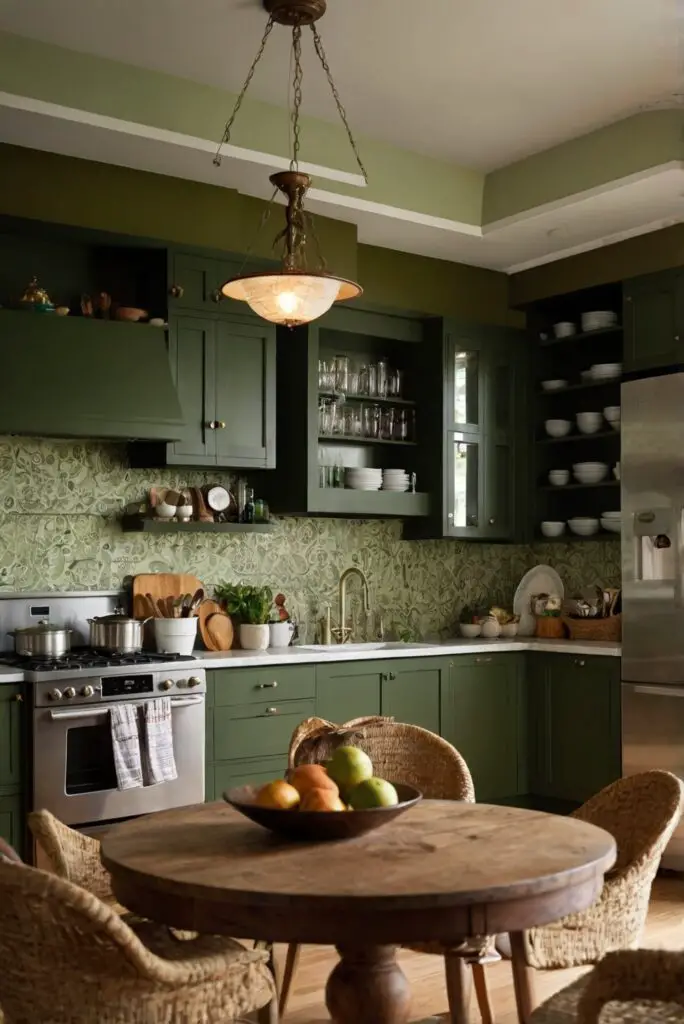Are you torn between traditional charm or bold creativity for your kitchen colors? Discover the ultimate guide to classic and eclectic color schemes here!
**
Do you prefer a classic or eclectic color scheme for the kitchen?
**
My Lovely Spring Paint for 2025
Ready for a Spring Makeover? Explore the Freshest 2025 Paint Trends!
White Sage/Green SW Pistachio green Soft blue Honeysweet/Orange Pink Sugar Sage Tint BMAs an Amazon Associate, I may earn a commission from qualifying purchases at no extra cost to you.
**
As a daily routine with an interior designer, I always recommend a classic color scheme for the kitchen. Classic colors like white, cream, beige, and light grey create a timeless look and make the space feel more open and airy. These colors also provide a versatile background for various decor styles and accessories. To ensure a cohesive look, consider adding pops of color through kitchen essentials like dish towels, small appliances, or decorative items. By sticking to a classic color palette, you can easily adapt your kitchen’s decor to changing trends without a complete overhaul. Proper space planning and color matching are essential for a harmonious design that suits your preferences and lifestyle.
**
Classic Color Options for a Kitchen Color Scheme
Classic color options for a kitchen color scheme often include timeless hues such as white, cream, gray, navy blue, and soft shades of green. These colors provide a neutral backdrop that can work well with a range of design styles and kitchen layouts. White kitchens, in particular, are a popular choice for their clean and airy feel, making the space appear larger and more inviting. Cream and gray tones are also versatile and can be easily paired with various accents and finishes. Navy blue adds a touch of sophistication and depth to the kitchen, while green tones create a calming and natural ambiance.
Incorporating an Eclectic Color Scheme
My fAV Spring DECOR for 2025
Discover Spring’s Best 2025 Decor Combinations – Perfect for Any Room!
Oversized Indoor Plants White Curved Sofas Rugs BOH Brown Cream Moroccan Hype Boho Rug Outdoor Patio Furniture Sets Topfinel Pillow CoversAs an Amazon Associate, I may earn a commission from qualifying purchases at no extra cost to you.
To incorporate an eclectic color scheme into your kitchen design, mix and match bold and vibrant colors with more subdued tones. Consider using a combination of primary colors like red, blue, and yellow, complemented by secondary colors like orange, green, and purple. Don’t be afraid to experiment with unexpected color pairings to create a visually stimulating and dynamic space. Introduce colorful accents through kitchen accessories, textiles, artwork, and even furniture pieces to add personality and character to the room.
Mixing Different Color Hues for an Eclectic Look
Yes, you can mix and match different color hues in your kitchen to achieve an eclectic look. Embrace contrast by pairing complementary colors such as blue and orange, red and green, or yellow and purple. Consider incorporating a mix of warm and cool tones to create balance and visual interest. Playing with different color intensities and saturations can also add depth and dimension to the space. Experiment with different color combinations until you find a harmonious mix that reflects your unique style and personality.
Popular Paint Alternatives for a Classic Kitchen Color Scheme
In addition to traditional paint colors, there are several popular alternatives for creating a classic kitchen color scheme. One option is to use wallpaper to add texture and pattern to the walls. Wallpaper can give your kitchen a vintage or traditional look, especially when paired with neutral cabinetry and countertops. Another alternative is to incorporate tiles in various colors and patterns as a backsplash or accent wall. Tiles provide a durable and easy-to-clean surface while adding visual interest and sophistication to the kitchen.
Choosing Colors that Match Existing Decor
When choosing colors for your kitchen that match the existing decor, consider the dominant colors in the room such as cabinet finishes, countertop materials, flooring, and appliances. Select colors that complement or contrast with these elements to create a cohesive and harmonious look. Take into account the natural light in the space and how it may affect the perception of color. If your kitchen has a predominantly neutral palette, adding pops of color through accessories, textiles, and artwork can enhance the overall design and tie everything together.
Tips for Organizing a Kitchen with an Eclectic Color Scheme
Organizing a kitchen with an eclectic color scheme involves balancing the various colors and elements to create a cohesive and harmonious look. Start by establishing a color palette that includes a mix of primary, secondary, and accent colors. Use these colors strategically to create focal points and visual interest throughout the space. Consider grouping similar colors together to create a sense of cohesion, while also allowing contrasting colors to stand out and add excitement. Incorporate plenty of storage solutions to keep clutter at bay and maintain a sense of order in the kitchen.
Importance of Color Selection in Kitchen Design
Color selection is crucial when designing a kitchen as it sets the tone and mood of the space. Colors have the power to evoke emotions, influence behavior, and create visual impact. The right color scheme can make a small kitchen feel larger, a dark kitchen feel brighter, and a bland kitchen feel more vibrant. By carefully selecting colors that resonate with your personal style and functional needs, you can create a kitchen that is visually appealing, inviting, and functional for everyday use.







